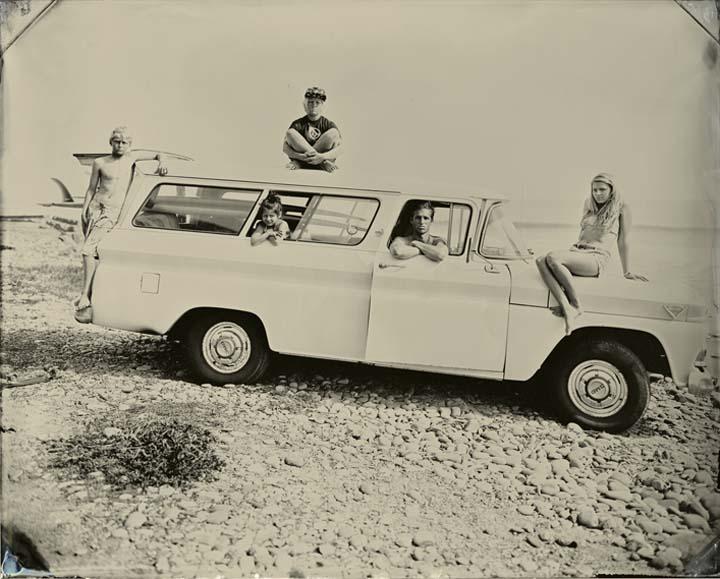Joni Sternbach: SurfLand
Joni Sternbach’s recent book, Surf Site, Tin Type, is enjoying a strong reception, with images from that collection featured at Photo Basel this week, as well as in an exhibition on classic photo processes at Musée de l’Elysée that continues through the end of August. She recently replied to an exclusive Q&A for DART:
Q: When and why did you take up large-format photography?
A: I have been photographing with large format cameras since I first studied photography in my 20’s, but it wasn’t my preferred format of choice till the late 1990’s.
Once I began working with wet-plate collodion it was more a question of how large a camera I wanted to deal with. The plate is only as big as your camera, so if you want larger plate, you’ll need a larger camera.
Q: What were you working on when the first surfers presented themselves?
A: I was shooting the series, Ocean Details. These are large format, abstracted seascapes of the ocean surface with a very narrow point of view. I was positioned on a bluff (just minding my own business) when surfers found their way into my frame. Surfers have often found their way into my pictures, whether I liked it or not. It took me a few years to pay attention to that in a more direct way.
Q: What is there about surfers that makes them such great subjects for you?
A: I think of surfers and the oceanic horizon in a similar way to the way we once thought of cowboys and the western mythology. The icon of the surfer seems to have supplanted the place of the cowboy within the American imagination. The physical and social experience of photographing surfers is what makes them such great subjects for me. There is a spirit of adventure and of the unknown each time I set out on a location to shoot and it’s exhilarating. It’s sort of like a surfer heading out in search of the next wave.
It’s also the experience of randomly meeting and conversing with individuals that I would never otherwise have had a chance to meet. It’s using the camera to create a conversation, and sometimes that dialogue is intensely personal and profound. It’s connecting with people on a common ground that is our natural environment and each person there shares that same love of the ocean that I do.
Q: What is there about the ocean’s edge that appeals to you?
A: It is this liminal place between land and sea, a dividing line between action and stability; it’s a constantly shifting scene.
Q: The people in your photographs exude an almost otherworldly calmness; what do you attribute this to?
A: Perhaps the calmness comes from the time between meeting my subject and when I take their picture. There is a lot to do before actually releasing the shutter, from composing the shot to coating and sensitizing the plate. I like to interact with and get to know my surfers during this period. I think that this extraordinary waiting period eases away a bit of self-consciousness.
Q: What prompted you to take up the wet plate collodion process? What are some of the advantages of this time-consuming, and seemingly difficult process?
A: I learned wet-collodion on a kind of lark. I took a weekend workshop in upstate New York and got completely hooked. I hadn’t sought it out, like I had other historic printing processes, in order to pursue a specific project.
Collodion is not known for its advantages, however one huge benefit to this process is the immediacy. I call it the Polaroid of yesteryear. It’s also a type of performance and conversation piece. It’s a tool that’s helped me to connect with my subjects more easily.
Q: How do you encourage your subjects to remain still enough long
A: Snacks (haha—only sometimes). I explain what’s involved, which is only holding still and not blinking during the exposure. The time while they are waiting for me to prepare the plate, they are just place holding the shot.
Q: Has the slowness of the process changed your internal clocks in any way?
A: I think the process has changed my internal clock. There’s a rhythm to the entire event, from the prepping of the chemicals and gear, to getting to the location, and finally, to shooting. There’s an unpredictability to this process (more than the speed) that has affected me. I try to be prepared for many conditions (wind, rain, tides) but in reality, I cannot anticipate what is going to happen during the course of a shooting day. That unknowing allows me to enjoy the time I spend on the beach and take every experience as it comes. Sometimes there are mishaps and it is an imperfect process, though I have learned to love and (sometimes) accept those wet plate characteristics.
Q: What are you working on now?
A: I am continuing to work on my SurfLand series, to make it more of a global project and to make larger plates (11x14 inches, 16x20 inches) and multiple plate panels. And I ‘ve started working on a series of large format film photographs of the beaches and waterways surrounding Fort Tilden and Dead Horse Bay, in Brooklyn/Queens.
Joni Sternbach uses early photographic processes to create contemporary portraits and environmental landscapes. Her long-term projects involve the pursuit and understanding of the western landscape and the series SurfLand, which captures portraits of surfers in tintype. Sternbach’s first monograph, SurfLand, was also a solo exhibition, at the Peabody Essex Museum in Salem, Massachusetts in May 2009. SurfLand traveled to Blue Sky Gallery and the Southeast Museum of Photography. In 2012, Surfland Revisited, 2006-2011 opened to acclaim at Rick Wester Fine Art in New York City. More





